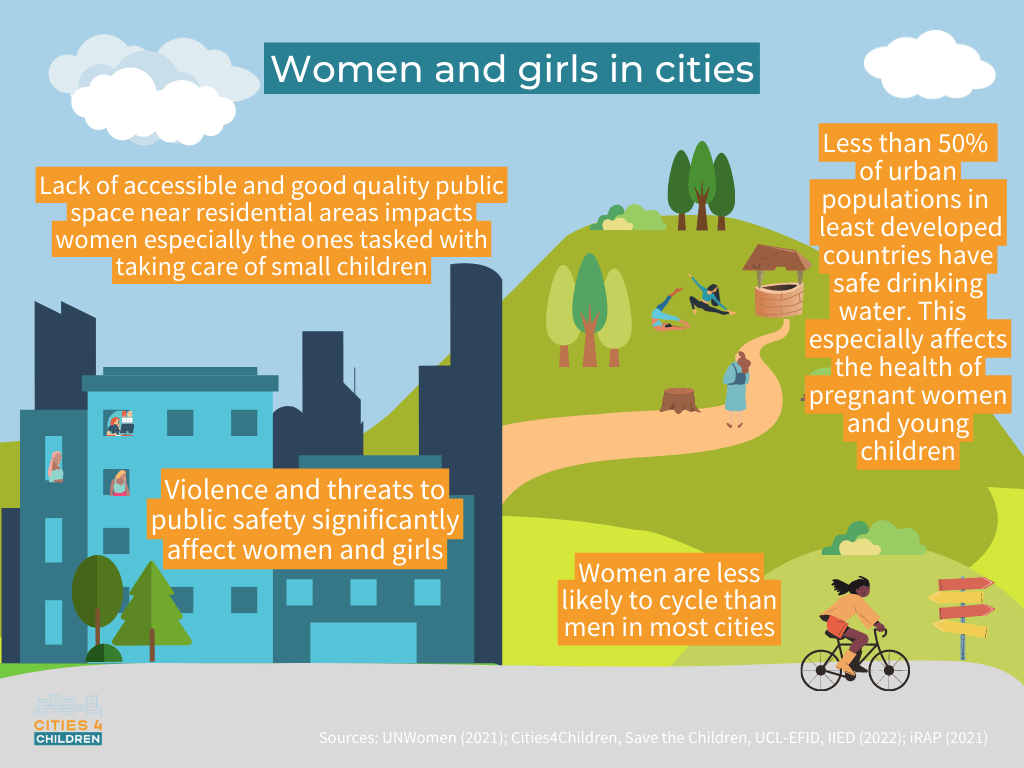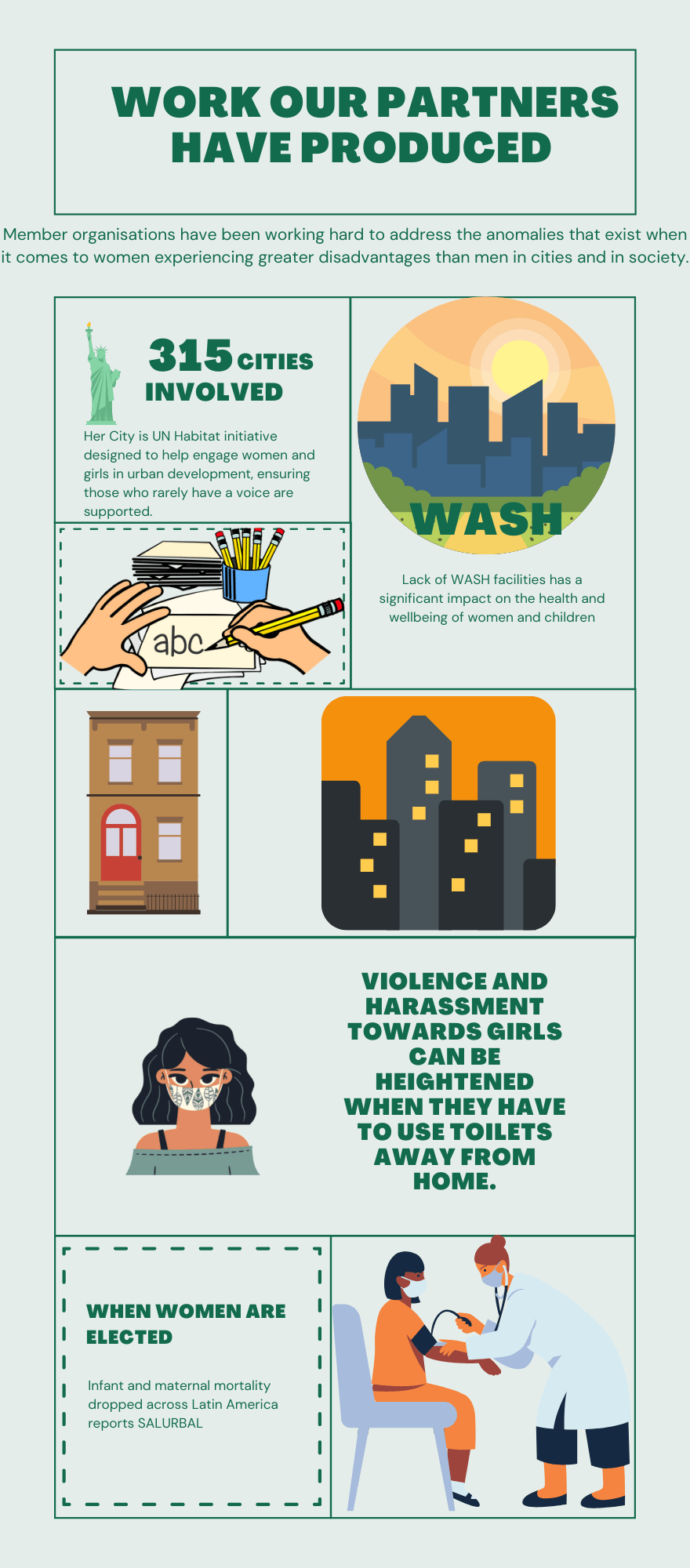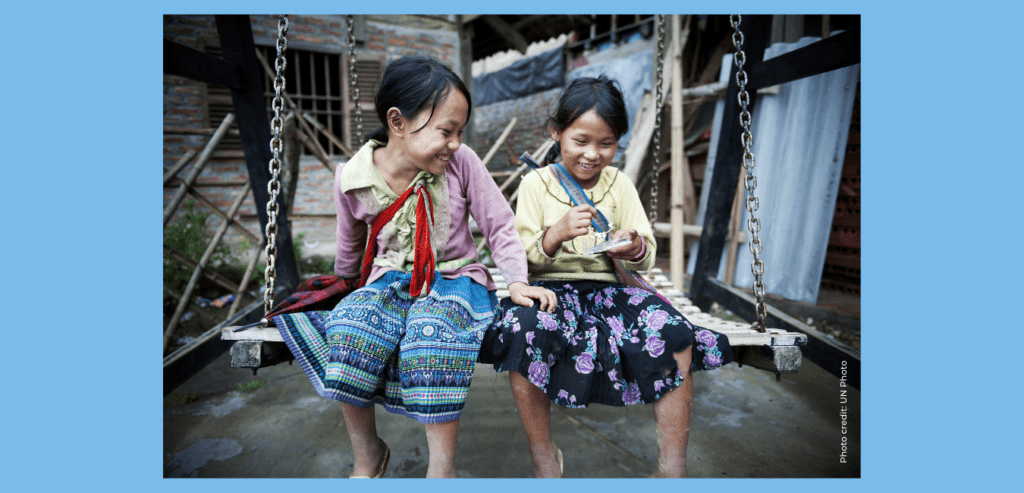Author: Cities4Children
This International Women’s Day, the Global Alliance – Cities4Children, asked member organisations about the work they do with women and girls in cities around the world. We also asked them to flag any surprising statistics, critical projects, or issues that they have worked on and which predominantly affected girls.
Finally, our partners shared some reports or studies that they had published recently that were relevant to an audience interested in issues faced globally by women and girls. Here are some highlights from our members for International Women’s Day 2022.

Image Credit: Isis Palay
Some of the issues faced by women and girls
Across our member organisations here are some of the issues that came up:
- Limited representation in governance structures leading to poor access to all services – including safety, education and mobility
- Poor and unsafe public transport continues to be an issue for women
- [Lack of] accessible and good quality public space near residential areas,” impacts women, especially those tasked with taking care of small children
- Insufficient street lighting only compounds poor quality public spaces
- Housing is also as a significant issue
- Lack of secure tenure and land
- “Post disaster shelter and housing needs are often lacking inputs by women and young girls”
- Violence and more threats to safety significantly affect women and girls more than men.
Some relevant reports that our partners have released over the past year
Global Alliance – Cities4Children’s member organisations have brought out a number of reports over the past year, many of which are related to creating safer cities for women and girls.
Supporting participatory processes to plan a city for everyone
Her City is a UN Habitat initiative about engaging women and girls in urban development to ensure that their voices are heard. Her City supports participatory processes that are important when it comes to planning a city for everyone.
- The idea behind Her City is to make tools and methods available to urbanists and cities across the world to support girls’ participation as part of long-term strategies to build sustainable cities and societies.
- So far, 315 cities across the world are involved in Her City, with 820 participants in total.
Links between children and WASH
Cities4Children in collaboration with UCL, Save the Children and IIED published a report highlighting links between lack of WASH (Water, Sanitation and Hygiene) and well-being of children in slums.
Some highlights from the report:
- An ever-growing number of urban dwellers, far more than officially recognised, live with levels of WASH provision that threaten their health, safety, comfort, dignity and productivity.
- Globally, 1 in 4 people lack safe drinking water, close to half no access to safely managed sanitation solutions and over a third lack the potential for safe hygiene at home.
- The provision of inadequate WASH has important implications for the safety and dignity of girls and women.
- Violence and harassment towards girls can be heightened when they have to use toilets away from home.
- Girls’ education can also be compromised by a lack of adequate sanitation facilities as they might miss school when menstruating. This can result in school drop-out and lower literacy rates.

Image Credit: Eleanor Ross
Women in power can lead to drop in infant mortality
SALURBAL, or The Urban Health Network in Latin America and the Caribbean, conducted a study on ‘Infant Mortality in Latin American Cities’ that showed that the presence of a higher proportion of empowered women, is linked to lower infant mortality. SALURBAL researchers conducted a study focused on Brazilian municipalities, which showed that reductions in municipal infant mortality over time were associated with the election of a woman in elected offices in the municipality.
Another study (paper and brief) examined the association of measures of women’s empowerment with infant mortality in 286 cities in 9 Latin American countries and showed that:
- A higher proportion of women participating in the labour force was associated with lower infant mortality (6% lower) in Latin American cities, regardless of the level of healthcare access or socioeconomic conditions of infants in the cities.
Researchers found that this association is likely linked to efforts made by these elected officials to expand access to primary health care and conditional cash transfer programs within their municipalities.
Unique barriers faced by women and girls in cities
Arup has been working on a publication focused on designing cities for, and with women, alongside UNDP and the University of Liverpool.
- Around the world, girls and women living in cities face a range of unique barriers and vulnerabilities. These include gender-based violence, unpaid care work, limited control over assets, and unequal participation in private and public decision-making.
- As part of the report, Arup explores how designing cities for women has gained great momentum in recent years. Unfortunately, it takes the most egregious acts – for example, the murders of Sabina Nessa and Sarah Everard in the UK – to reignite the debate on women’s safety. However, Arup’s research shows that other fundamental needs, including Health & Wellbeing, Self-actualisation & Enrichment, and Justice & Equity, are equally important to consider.
- Drawing on case studies from cities around the world, their research underlines the main strategies and actions necessary to support these needs, and to address existing challenges and gaps. The report, out in June, considers different types of interventions, including physical design, behavioural approaches, and policy initiatives, across different geographies globally. Similarly, it illustrates the role that a broad constituency of stakeholders has to play – from city governments, to non-governmental organisations, to individuals.
These are just some of the reports, studies and facts released recently by our partners. At Cities4Children – The Global Alliance, everyone understands the importance of equality. Making life in cities better for women and girls, is making life better for humanity and for children. Read more about our partners’ work here.
This work is licensed under a Creative Commons Attribution-NonCommercial-NoDerivatives 4.0 International License. When re-sharing this content please ensure accreditation by adding the following sentence: ‘This blog was first published by the Global Alliance – Cities 4 Children (www.cities4children.org/blog)’

